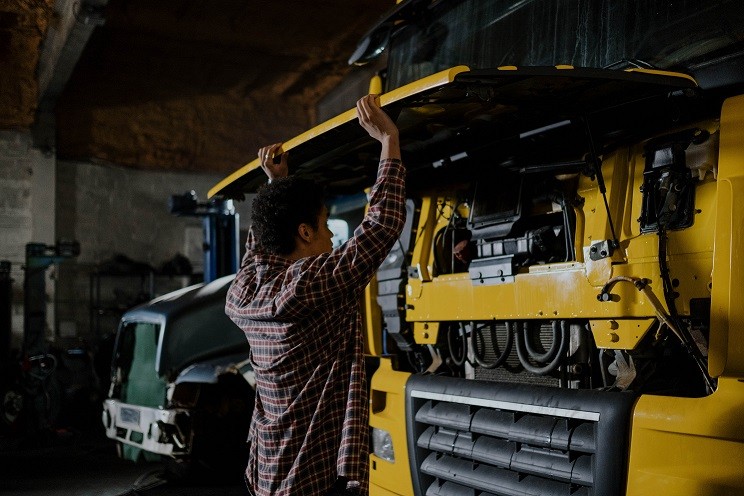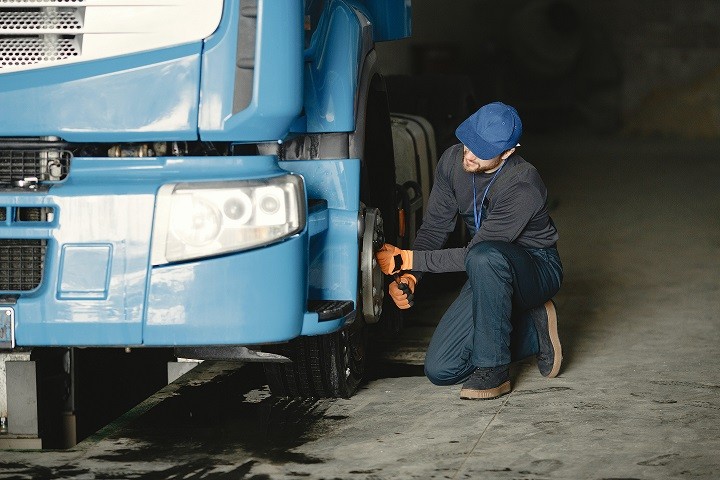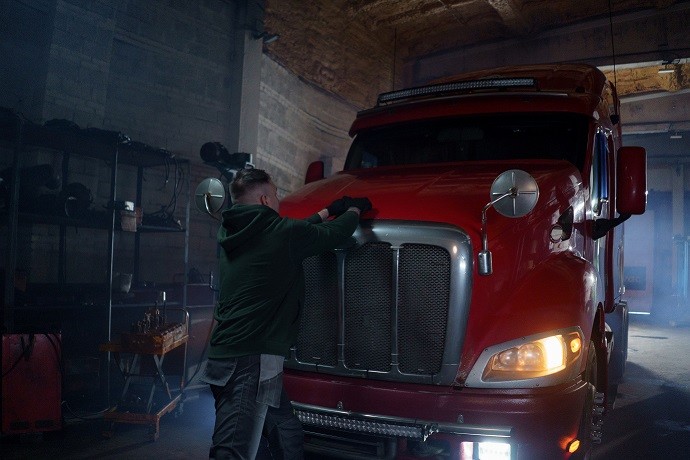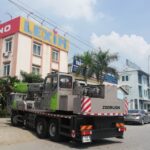To operate a powerful and efficient truck, thousands of different parts must work together seamlessly. Understanding the parts of a truck not only helps you drive more safely but also provides valuable support in maintenance and repair. This article from Xe Tải Mỹ Đình will provide a comprehensive look at truck construction, from the exterior to the engine and other important parts.
Why Is Understanding Truck Parts Important?
Having a solid understanding of truck construction provides many practical benefits for users. When you understand the function of each part, you will:
- Improve Driving Safety: Recognizing unusual signs from components helps you detect potential problems early and take timely action, ensuring safety on every journey.
- Easier Maintenance and Repair: Knowledge of parts helps you be more proactive in regular inspections, maintenance, and even fix minor problems yourself, saving time and money.
- Optimize Operating Performance: When you understand how the parts work together, you can drive more efficiently, save fuel and extend the life of the vehicle.
- Choose the Right Replacement Parts: In the event of needing to replace components, knowledge of the parts helps you choose the correct type of parts, ensuring the vehicle operates stably after repair.
 [Alt: Illustration showing the basic components of a truck, including the cabin, cargo box, chassis, and wheels.]
[Alt: Illustration showing the basic components of a truck, including the cabin, cargo box, chassis, and wheels.]
Exploring the Details of Truck Parts
Trucks are made up of countless parts, but we can divide them into main groups for easy understanding:
1. Truck Exterior Parts: The Outer Appearance
These are the parts you can directly observe outside the vehicle, playing an important role in ensuring safety, aesthetics and aerodynamics for the vehicle:
- Radiator Grille: Located at the front of the vehicle, the radiator grille’s main function is to ventilate, helping to cool the engine by allowing air to flow through the cooling water tank.
- Bumper: The part that protects the front and rear of the vehicle, minimizing damage when collisions occur. Bumpers are often made from high-strength materials such as steel or composite plastic.
- Headlights: The main lighting system of the vehicle, ensuring visibility for the driver at night or in bad weather conditions. Headlights usually include low beam and high beam lights.
- Turn Signals (Directional Lights): Signals the direction of the vehicle’s movement to other vehicles, increasing safety when participating in traffic.
- Brake Lights: Signal lights at the rear of the vehicle light up when the driver steps on the brake, warning vehicles behind to slow down, avoiding collisions.
- Rearview Mirrors: Includes interior and exterior rearview mirrors, helping the driver observe the rear and sides of the vehicle, eliminating blind spots and ensuring safety when changing lanes, turning or reversing.
- Cabin: The front part of the vehicle, which houses the driving compartment and engine (for trucks with front cabins). Cabin design greatly affects the aerodynamics and aesthetics of the vehicle.
- Windshield: Protective glass in front of the cabin, blocking wind, dust and impacts from the external environment, while ensuring clear visibility for the driver.
- Steps: Helps the driver and passengers get in and out of the vehicle easily and safely, especially with truck models with high cabins.
- Mudguards: Installed above the wheels, mudguards help prevent mud, dirt and rocks from splashing onto the vehicle body and surrounding vehicles, keeping the vehicle clean and increasing safety.
 [Alt: Close-up photo of the truck’s exterior parts, focusing on the headlight, radiator grille, and front bumper.]
[Alt: Close-up photo of the truck’s exterior parts, focusing on the headlight, radiator grille, and front bumper.]
2. Truck Cabin Interior Parts: The Driver’s Workspace
The cabin is the driver’s main workspace, equipped with many comfortable and supportive driving parts:
- Steering Wheel: The part that controls the direction of the vehicle. Modern steering wheels often integrate other function control buttons such as horn, sound adjustment, and cruise control.
- Dashboard: Displays important information about the vehicle’s operating status such as speed, engine RPM, fuel level, engine temperature, and warning lights.
- Accelerator, Brake, Clutch Pedals: Parts that control speed, deceleration and gear changes (for manual transmission vehicles). The position and design of the pedals are optimized to provide comfort and ease of operation for the driver.
- Gear Lever: Used to switch between different gears, adjusting the vehicle’s speed and traction.
- Seats: Truck seat design focuses on comfort for the driver on long journeys. Seats are often adjustable in position, backrest recline, and integrated with a shock absorption system.
- Air Conditioning System: Ensures the cabin space is always cool and comfortable, especially in hot weather conditions.
- Entertainment System: Radio, CD player, USB connection port… help the driver relax and entertain while driving.
- Seat Belt: The most important passive safety device, protecting the driver and passengers in the event of a collision.
- Windows and Window Lifting Mechanism: Provides side visibility and ventilation for the cabin.
3. Truck Engine Parts: The Heart of Power
The engine is the powerhouse of the truck, responsible for generating energy for the vehicle to move:
- Engine: The most complex part of the vehicle, converting energy from fuel (diesel or gasoline) into mechanical energy, creating rotational motion to transmit to the transmission system.
- Gearbox/Transmission: Adjusts the gear ratio between the engine and the wheels, helping the vehicle operate efficiently at different speeds and loads. Gearboxes can be manual or automatic.
- Spark Plug (for gasoline engines): The part that creates an electric spark to ignite the fuel and air mixture in the gasoline engine’s combustion chamber.
- Exhaust Pipe: Directs exhaust gases from the engine to the outside environment. Modern exhaust systems often integrate exhaust filters to minimize pollution.
- Starter: Starts the engine from a stationary state by creating an initial rotation for the engine crankshaft.
- Radiator: Maintains a stable operating temperature for the engine, preventing overheating and causing damage.
 [Alt: Detailed image showing the internal components of a truck engine, including the piston, cylinder, and crankshaft.]
[Alt: Detailed image showing the internal components of a truck engine, including the piston, cylinder, and crankshaft.]
4. Chassis and Drivetrain Parts: A Solid Foundation
The chassis and drivetrain are the basic foundation, ensuring the truck’s load-bearing capacity, movement and stable operation:
- Chassis/Frame: The main load-bearing structure of the vehicle, supporting all other parts and ensuring the vehicle’s rigidity.
- Suspension: Reduces shock and vibration from the road surface to the vehicle frame and cabin, providing smoothness for people in the vehicle and protecting goods. The suspension can be spring, leaf spring, or air suspension.
- Propeller Shaft: Transmits rotational motion from the gearbox to the drive axle (usually the rear axle), helping the vehicle move.
- Drive Axle: The part that transmits force directly to the wheels, helping the vehicle move. Trucks can have one or more drive axles depending on the design and load capacity.
- Brake System: Ensures the ability to decelerate and stop the vehicle safely. The brake system can be drum brakes or disc brakes, combined with ABS anti-lock braking system and EBD electronic brake force distribution on modern vehicles.
- Steering System: Allows the driver to control the direction of the vehicle through the steering wheel and steering mechanisms.
- Wheels: Parts that make direct contact with the road surface, bearing the load of the vehicle and goods, and ensuring mobility. Wheels include tires and rims.
5. Other Parts: Completing the Truck
In addition to the main groups of parts above, trucks also have many other parts that play an important role in operation and use:
- Cargo Box/Truck Bed: The cargo carrying space of the truck. There are many different types of cargo boxes such as closed boxes, open boxes, semi-open boxes, refrigerated boxes… depending on the purpose of use.
- Fuel Tank: Contains fuel to supply the engine for operation. The fuel tank capacity determines the vehicle’s travel distance after each refueling.
- Battery: Provides electrical energy for the starting system, lighting, and other electrical equipment on the vehicle.
- Spare Tire: A replacement tire in case the main tire is damaged on the road.
- Antenna: Receives and transmits radio waves, serving the entertainment and communication system.
- License Plate: Identifies the vehicle, helping authorities manage and recognize the vehicle.
- Windows: Provides natural light and visibility around the cabin for people inside.
What Part Is the Most Important on a Truck?
Each part of the truck plays its own role and contributes to the overall operation of the vehicle. However, if we had to choose the most important part, it would be the engine.
The engine is like the “heart” of the truck. Without an engine, the truck cannot move. Although other parts are also important and necessary, the engine is the source of the truck’s power and operating capability. Maintaining and caring for the engine properly is the key factor to ensure that the truck always operates durable and efficiently.
 [Alt: Close-up image of a truck engine, the most crucial component ensuring the vehicle’s operation.]
[Alt: Close-up image of a truck engine, the most crucial component ensuring the vehicle’s operation.]
Conclusion
The above article from Xe Tải Mỹ Đình has provided an overview of truck parts. Understanding the structure and function of each part not only helps you use the vehicle more effectively but also contributes to improving safety and extending the life of your truck. Hopefully this information will be useful to readers, especially those working in the transportation field and interested in trucks.
